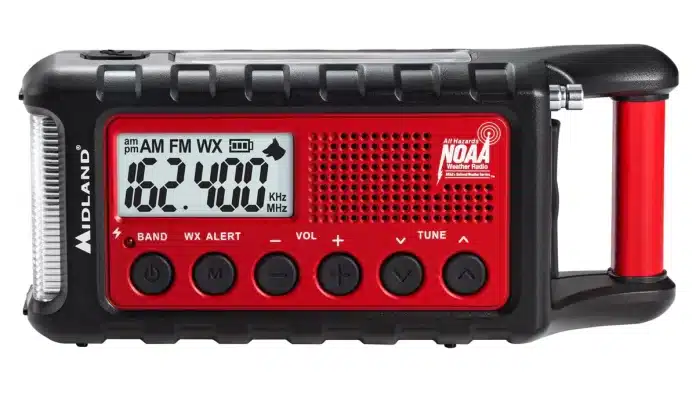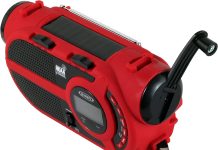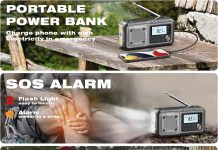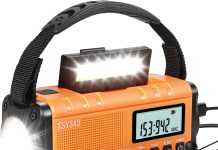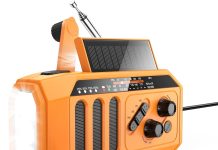In this article, we uncover the answer to a question: How often should we replace the batteries in an emergency radio? This little device holds immense importance in times of crisis and can be a lifeline for us.
So, knowing when to ensure its batteries are in top-notch condition becomes crucial. Stick around as we navigate the reasons behind battery replacements and provide valuable tips to ensure our emergency radios are always prepared to serve us when we need them the most.
Review contents
Importance of Battery Replacement in an Emergency Radio
Ensuring Reliable Functionality
In times of emergency, having a reliable source of information is crucial. An emergency radio plays a vital role in informing us about developments or warnings. However, without proper battery maintenance, the radio’s functionality could be compromised, rendering it ineffective when we need it the most. Therefore, prioritizing battery replacement in an emergency radio is of utmost importance to ensure it functions reliably during critical moments.
Maintaining Emergency Preparedness
Emergency preparedness requires proactive measures to be taken, and maintaining the functionality of the emergency radio is an essential part of it. When disaster strikes, communication channels may become disrupted, making it difficult to gather accurate information. An emergency radio with a functioning battery becomes valuable in such situations, providing us with the latest updates and instructions. By replacing the batteries regularly, we can be confident that our emergency radio will be ready to serve its purpose, providing us with a lifeline to the outside world.
Factors Affecting Battery Life
Battery Type
The type of battery used in an emergency radio significantly affects its lifespan. Different batteries have varied characteristics, including their longevity. It is essential to consider the type of battery recommended by the manufacturer and understand its expected lifespan. Some common battery types used in emergency radios include alkaline, lithium, and rechargeable batteries. Each type has pros and cons, and understanding these differences will help us make an informed decision while choosing the correct battery for our emergency radio.
Radio Usage
The frequency and duration of radio usage also impact the battery life. If the emergency radio is used extensively, especially for extended periods, the batteries will likely drain more quickly. Therefore, it is vital to consider how often and for how long we use the radio to accurately estimate the battery replacement frequency. If the radio is only used sparingly for occasional updates, the batteries may last longer, reducing the need for frequent replacements.
Storage Conditions
The way an emergency radio is stored can affect battery life as well. Extreme temperatures, either too high or too low, can degrade the batteries and shorten their lifespan. It is essential to store the radio in a cool and dry place, avoiding exposure to direct sunlight or excessive humidity. Additionally, storing the radio without batteries when not in use can also help preserve the battery life. Considering the storage conditions, we can minimize the impact on battery longevity and ensure the radio is always ready for use.
Determining Battery Replacement Frequency
Manufacturer’s Recommendations
The manufacturer’s recommendations are a primary source of guidance regarding how often to replace the batteries in an emergency radio. The user manual or product packaging usually provides clear instructions regarding battery replacement frequency. Following these recommendations is crucial to maintain optimal functionality and ensure our emergency radio is always prepared for any situation. Manufacturers design their radios with specific battery requirements, and adhering to their guidelines will help us make the most of our device.
Frequent Radio Use
Frequent usage of the emergency radio can significantly impact the battery lifespan. The batteries will likely deplete faster if we rely on the radio for daily updates or use it consistently throughout the week. In such cases, replacing the batteries more frequently than occasional or monthly use may be necessary. Understanding our radio usage patterns will give us valuable insights into how often we should expect to replace the batteries, allowing us to plan accordingly and ensure uninterrupted functionality.
Storage Duration
The duration we store the emergency radio without using it also affects battery life. The batteries can slowly discharge if the radio remains unused for long periods. It is essential to consider the storage duration and factor it into our battery replacement frequency. Short-term storage may require less frequent battery replacements, while long-term storage, such as keeping the radio in a survival kit, may warrant more regular battery checks and replacements.
Regular Battery Testing
Regular testing is a valuable practice to determine when to replace the batteries. Checking the battery voltage can help us assess their current state and estimate how long they will last. Most emergency radios have a battery indicator or a built-in battery tester that can provide such information. External battery testers can also serve the purpose if the radio doesn’t have a built-in tester. By incorporating regular battery testing into our routine, we can accurately gauge when it’s time for a replacement, ensuring optimal functionality.
Manufacturer’s Recommendations
Check the User Manual
To determine the battery replacement frequency, consult the user manual provided by the manufacturer. The user manual contains valuable information regarding the specific battery requirements and recommendations for the particular emergency radio model. It will outline the expected battery life and suggest when replacement is necessary. By familiarizing ourselves with the instructions in the user manual, we can ensure our emergency radio operates optimally and be aware of any specific considerations for battery replacement.
Contact Customer Support
If we have any doubts or concerns regarding battery replacement for our emergency radio, contacting the manufacturer’s customer support is advisable. We can obtain accurate and personalized advice tailored to our specific device by directly contacting the manufacturer. Customer support representatives can provide additional guidance on battery replacement frequency and address any questions or uncertainties. Utilizing customer support expertise can help us make informed decisions regarding our emergency radio and its battery maintenance.
Frequent Radio Use
Daily Use
Using the emergency radio daily for extended periods will drain the batteries more quickly. In such cases, replacing the batteries more frequently is recommended, adhering to the manufacturer’s recommendations or based on our assessment of battery depletion. Daily usage puts a higher demand on the batteries, making it essential to stay proactive in maintaining their functionality. By replacing the batteries regularly in line with our daily usage, we can ensure continuous and reliable operation of our emergency radio.
Weekly Use
If we use the emergency radio every week, the battery replacement frequency will vary compared to daily use. While the batteries may last longer, it is essential to assess their performance regularly. Following the manufacturer’s recommendations or conducting battery tests can help determine when replacements are necessary. By being aware of our weekly usage pattern and monitoring battery life, we can stay prepared and replace the batteries as needed, ensuring the uninterrupted functionality of the radio.
Monthly Use
The battery life may last longer for those who use the emergency radio every month. However, monthly usage still requires periodic battery replacements to guarantee optimal functionality when needed. We can estimate when the batteries require replacement based on our monthly usage by planning ahead and keeping track of the radio’s performance. Staying vigilant and implementing a regular battery replacement routine will ensure our emergency radio is always prepared to serve its purpose reliably.
Storage Duration
Short-Term Storage
During short-term storage, such as when the emergency radio is not in use between emergencies, the batteries should ideally be removed or disconnected. Removing the batteries prevents unintentional battery drain and extends their overall lifespan. It is also recommended to store the radio in a cool and dry place, away from direct sunlight or excessive humidity. By following these best practices, we can prolong the battery life and be confident that our emergency radio will have functional batteries in times of need.
Long-Term Storage
In the case of long-term storage, such as keeping the emergency radio in a survival kit, regular battery checks become even more critical. The batteries can slowly discharge over time, even without usage, and it is essential to anticipate and prevent any potential battery failure. Periodic testing and replacement of the batteries are crucial to ensure the radio operates reliably during emergencies. Incorporating the radio into our routine maintenance checks will help us stay prepared and maintain functional batteries in our emergency radio.
Regular Battery Testing
Checking Battery Voltage
To determine the condition of the emergency radio batteries, checking their voltage is an effective method. Most radios have a built-in battery indicator or tester displaying the remaining battery power. By referencing this battery indicator, we can assess the amount of charge remaining and estimate when the batteries should be replaced. External battery testers can serve the same purpose if the radio does not have a built-in tester. Regularly checking the battery voltage will provide us with insights into their current state and inform our decision to replace them.
Using Battery Testers
External battery testers are valuable tools for assessing the health of emergency radio batteries. These testers typically measure battery voltage and provide accurate information regarding their condition. We can obtain precise readings of their remaining power by connecting the batteries to the tester. Battery testers are handy for radios without built-in testers, allowing us to stay proactive in determining the battery replacement frequency. By incorporating battery testing into our maintenance routine, we can ensure our emergency radio always has reliable batteries.
Signs of Battery Replacement
Weakening Signal Strength
One of the signs indicating the need for battery replacement in an emergency radio is a weakening signal strength. If we notice a decline in signal quality or difficulty picking up transmissions, it may be a sign of depleted batteries. As the batteries lose their charge, the radio’s ability to receive and transmit signals diminishes. If this occurs, it is crucial to replace the batteries promptly to restore optimal functionality and ensure clear communication during emergencies.
Shortened Battery Life
If the emergency radio’s batteries no longer charge for a reasonable period, it indicates that replacement is necessary. The batteries may start draining quickly or lose their capacity to power the radio for extended periods. When we notice a notable decrease in battery life from what we had previously experienced, it is time to consider replacing the batteries. By addressing this sign promptly, we can avoid any disruptions in the radio’s operation and maintain its reliability.
Intermittent Functionality
When the emergency radio exhibits intermittent functionality, randomly turning on and off or experiencing sudden drops in power, it may be a sign of inadequate battery performance. As the batteries age, their ability to provide a constant and stable power supply diminishes. Such erratic behavior can be frustrating and compromise the overall reliability of the radio. By recognizing these symptoms as an indication of battery inefficiency, we can ensure timely replacement and restore the radio’s consistent functionality.
Battery Replacement Tips
Use High-Quality Batteries
To maximize the performance and longevity of an emergency radio, it is essential to use high-quality batteries. Opting for reputable brands and reliable battery models will improve performance and durability. High-quality batteries ensure a consistent power supply and reduce the risk of unexpected failures during emergencies. Investing in reliable batteries ensures optimal functionality and greater peace of mind in critical situations.
Replace All Batteries at Once
When it comes time to replace the batteries in an emergency radio, it is strongly recommended to replace all of them simultaneously. Mixing old and new batteries can lead to imbalanced power distribution, potentially causing malfunctions or premature depletion. By replacing all batteries simultaneously, we can ensure uniform power delivery and proportional usage among the cells. This practice helps maintain optimal battery life and promotes the effective operation of the emergency radio.
Store Spare Batteries
Having readily available spare batteries is a wise precaution to ensure continuous functionality during emergencies. We can easily replace exhausted batteries when needed by storing spare batteries safely and separately from the emergency radio. Following the manufacturer’s instructions, storing spare batteries in a cool and dry place will help maintain their quality and prolong their lifespan. By having spare batteries at hand, we can be confident in the uninterrupted operation of our emergency radio.
Keep Track of Replacement Dates
To maintain an organized battery maintenance routine, keeping track of the battery replacement dates is advisable. We can easily monitor and estimate their lifespan by recording the dates when the batteries were replaced. This record will also help us identify patterns or trends regarding battery usage and replacement frequency. By staying organized and proactive in managing battery replacements, we can ensure our emergency radio is always prepared to serve its purpose.
Conclusion
In an emergency, having a functional and reliable source of information is of utmost importance. The battery of an emergency radio plays a crucial role in ensuring its functionality and overall performance.
By understanding the factors that affect battery life, such as battery type, radio usage, and storage conditions, we can determine the frequency at which batteries should be replaced.
Following the manufacturer’s recommendations, conducting regular battery testing, and monitoring signs of battery replacement allow us to stay ahead in maintaining the efficiency of our emergency radio.
By incorporating these practices and tips into our battery maintenance routine, we can prioritize functionality and adhere to the manufacturer’s instructions, ensuring our emergency radio is always prepared to serve us in critical moments.

